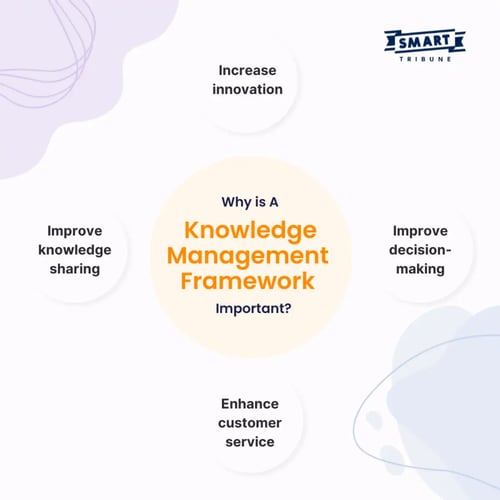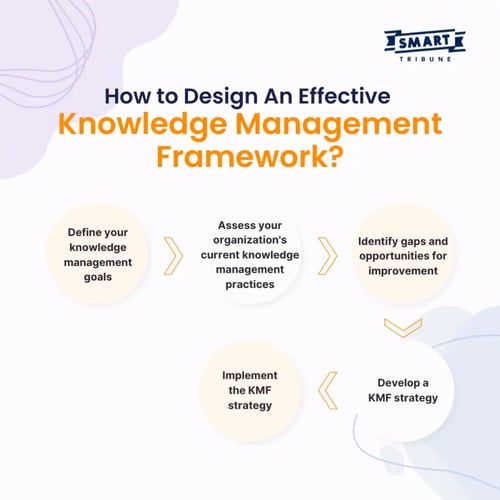
On MARCH 30, 2023
How to Develop A Knowledge Management Framework That Benefits Your Business
In today's fast-paced business environment, organizations are constantly looking for ways to stay ahead of the competition. One of the most effective strategies for achieving success is by harnessing the power of knowledge management. A well-designed knowledge management framework can help businesses of all sizes improve productivity, increase efficiency, and ultimately drive growth.
In this article, we'll dive deep into the world of knowledge management, and explore the various benefits that a robust knowledge management framework can offer and beyond:
- Comprehensive knowledge management framework definition;
- Indispensable role of knowledge management framework in business operation and customer service;
- How to develop a framework effortlessly;
- Components of a knowledge framework;
- FAQs about organization knowledge management.
If you are pumped and so am I, let’s get started!

What is A Knowledge Management Framework?
At its core, the knowledge management framework (KMF) involves creating, sharing, using, and managing the knowledge and information that is critical to the success of an organization. It provides a structured approach to capturing, storing, sharing, and utilizing knowledge and information within an organization.
In order to achieve any goal, businesses need to implement a structured approach that incorporates people, processes, and technology. Thus, a knowledge management framework provides the fixed format and guidelines necessary to ensure that knowledge is effectively captured, stored, and shared across the organization.
Check out 100+ top-notch knowledge base examples for customer self-service.
Why is A Knowledge Management Framework important?
A KMF is a game-changer for any organization looking to succeed in this modern business world. There are many benefits of implementing a knowledge framework within an organization, here are some of the key to consider:
Improve knowledge sharing
A KMF provides a structured approach to knowledge sharing within an organization, ensuring that knowledge is shared effectively across all levels and departments. When knowledge is shared effectively within an organization, it leads to better collaboration and teamwork, which in turn, can enhance productivity and performance.
Discover how an internal knowledge base will boost your employees efficiency!
For instance, a study by McKinsey & Company found that organizations with effective knowledge management practices have 50% higher employee productivity and 46% higher employee engagement than those without.
Increase innovation
A systematic study by the Journal of Corporate Information found that organizations that have implemented knowledge management frameworks are more likely to have a culture of innovation.
Thus, information management frameworks encourage innovation by providing teams with access to the knowledge and information they need to generate new ideas and approaches. Knowledge management can fuel innovation by enabling employees to access the information they need to generate new ideas and approaches. 
Improve decision-making
A knowledge management framework provides decision-makers with access to the knowledge and information they need to make informed decisions. This can lead to better decision-making, which can have a positive impact on an organization's performance.
For example, if the hospitals are able to employ KMF into the knowledge-stored system, doctors were able to quickly access the latest research on a particular condition, leading to more accurate diagnoses and better treatment plans. As a result, hospitals can see improved patient outcomes, reduced medical errors, and increased efficiency.
Enhance customer service
An organization knowledge management can bolster customer service by ensuring that employees have access to the knowledge and information they need to provide high-quality service to customers. This can lead to increased customer satisfaction and loyalty.
Imagine a bank applying a thorough KMF for the customer service department. When a customer called with a question about their account, the customer service representative was able to quickly access their account information and provide an answer in a timely manner. This is the secret to delivering an exceptional digital customer experience that increases customer satisfaction and loyalty. The reason is that customers feels that the bank is providing them with the level of service they expected.
At the same time, business owner can adjust internal knowledge base and turn it to a version for customer self-service.
Zoom in the basics of creating and managing a knowledge base for customer use.
How to Design An Effective Knowledge Management Framework?
Even though it is powerful, creating a framework is not a straightforward process. Without a clear strategy in place, organizations would risk losing valuable information and missing out on opportunities for growth.
In this section, we will explore how to develop a framework that will enable your organization to harness the power of knowledge and unlock success:

Step 1: Define your knowledge management goals
Defining your knowledge management goals is one of the most crucial knowledge management process steps. It involves identifying what your organization wants to achieve through knowledge management and setting clear and measurable goals to guide your efforts.
Here are some key considerations to keep in mind:
- Identify your organization's strategic objectives: Your corporate knowledge management’s goals should align with your organization's overall strategic objectives.
For example, if your organization's goal is to improve customer service, your knowledge management goals might focus on improving access to customer information and knowledge sharing among customer service teams.
- Identify your knowledge management priorities: Determine which areas of your organization are most in need of knowledge management improvements.
For example, you may want to focus on improving knowledge sharing between teams or creating a centralized knowledge repository.
- Set measurable goals: Your goals should be specific, measurable, achievable, relevant, and time-bound (SMART).
For example, a SMART knowledge management goal might be to reduce employee training time by 20% within six months by developing a comprehensive onboarding knowledge management program.
- Involve stakeholders: Involve key stakeholders in the goal-setting process to ensure that everyone is aligned and committed to the same objectives. This can include senior leaders, department heads, and front-line employees.
- Continuously review and revise goals: Review your knowledge management framework’s goals regularly to ensure they remain relevant and aligned with your organization's changing needs. It can also help you to identify new opportunities for improvement and innovation.
Step 2: Assess your organization's current knowledge management practices
The next step is to assess your organization's current knowledge management practices. By doing this, you can identify areas for improvement and develop a KMF that is tailored to your organization's needs and goals. The information gathered during this step will serve as the foundation for the development of the KMF.
Here are some key considerations to keep in mind:
- Review existing documentation: Start by reviewing your organization's existing documentation, such as policies, procedures, and manuals. This can help you identify areas where knowledge management processes are currently in place, as well as any gaps or inconsistencies.
- Conduct interviews and surveys: Speak with employees at all levels of the organization to gain insights into their experiences with the knowledge management framework, including what works well and what could be improved.
- Assess technology systems: Evaluate the technology systems currently in use to manage knowledge, such as content management systems, document repositories, and collaboration tools. Moreover, make sure to also assess their usability, functionality, and integration with other systems as well.
- Analyze data: Analyze data on knowledge management framework practices, such as user engagement with knowledge repositories and usage statistics. This can help you identify which knowledge assets are being used most frequently and where there may be gaps.
- Compare to best practices: Compare your organization's current knowledge management practices to best practices in your industry or sector. This can help you identify areas where your organization can improve and innovate.
Step 3: Identify gaps and opportunities for improvement
The third step of how to create a framework, you have to identify gaps and opportunities for improvement for knowledge management process. This will help you to develop a plan that is tailored to the specific needs of your organization:
- Identify gaps: Review the information gathered in step 2 to identify areas where the organization's knowledge management practices fall short of best practices or organizational goals.
Common gaps include incomplete or inaccurate documentation, inconsistent processes, and low user engagement with knowledge repositories.
- Identify opportunities: Look for opportunities to improve knowledge management practices, such as implementing new technologies, creating new processes, or providing training to employees. These opportunities can arise from gaps identified in step 2 or from broader organizational goals.
- Prioritize gaps and opportunities: Then, prioritize them based on their potential impact on the organization's goals and the resources required to address them. Prioritization can help ensure that the most critical gaps are addressed first and that the organization's resources are used effectively.
Step 4: Develop a KMF strategy
Based on the gaps and opportunities for improvement identified in step 3, you can develop a KMF strategy. This is where you take the knowledge gaps and opportunities you've identified and turn them into actionable plans that will drive your organization towards success.
- Identify actions and initiatives: Identify the actions and initiatives necessary to achieve the goals and objectives of the KMF strategy. These may include developing new processes, implementing new technologies, creating new knowledge repositories, or providing training to employees.
- Assign roles and responsibilities: Consider creating a knowledge management team or assigning specific individuals to lead initiatives and monitor progress. This helps to ensure accountability and keeps everyone on track towards achieving the desired outcomes.
- Establish metrics and measures: By regularly measuring progress, you can make adjustments and optimize your KMF strategy for continued success.
Some of the most popular measurements include user engagement with knowledge repositories, the number of knowledge management initiatives completed, or improvements in decision-making or customer service.
Step 5: Implement the KMF strategy
Once you have defined your knowledge management framework’s strategy, it's time to put it into action. This involves executing the actions and initiatives identified in the previous step and ensuring that the strategy is integrated into the organization's day-to-day operations.
- Communicate the strategy: Get everyone on board with the KMF approach and know their part in making it a success. Company-wide emails, town hall meetings, and training sessions are all good options for this.
- Provide resources: Provide the KMF strategy's recommended actions and initiatives the funding they need to succeed. This might be in the form of money, tools, or people.
- Monitor progress: Set up checkpoints at regular intervals to evaluate progress and make course corrections. Step 4's metrics and measurements, as well as staff and customer input, may be examined at this point.
- Get people involved: In order to foster knowledge sharing and innovation, it's important to encourage employee engagement and teamwork. Incentives and recognition programmes for workers who contribute to the knowledge management system may be developed as part of this process.
- Improve continuously: Make that the KMF plan is still in line with the rest of the company's goals and strategies by evaluating it frequently and making any necessary adjustments. Improving the effectiveness of the knowledge management system may need adjusting to shifts in the sector or the market, or adopting new technology.
What are The Components of A Knowledge Management Framework?
A Knowledge Management Framework is like the backbone of an organization's knowledge management system. It provides the necessary structure and support for the effective management of knowledge assets. A well-designed KMF can help an organization maximize the value of its knowledge assets, increase innovation and productivity, and enhance its competitive advantage.
Different organizations of different sizes and in different fields will require a different component of knowledge management. However, a KMF will often have the following parts:
- Strategy: Through KMF, the company lays out its plans for the long-term care of its intellectual property. It specifies how the KMF should be implemented and establishes the overarching strategy for knowledge management.
- People: KMF is concerned with the human assets of knowledge management. Knowing who works with knowledge, what they do, and equipping them with the tools they need to do their jobs well are all part of creating a knowledge management team.
- Technology: The focus of KMF is on the many technologies that contribute to effective knowledge management. Part of this process is figuring out what technologies are most important to your company and making sure they're properly integrated and in line with your goals.
- Culture: KMF explores the effects of an organization's culture on its knowledge management practises. Building a culture of knowledge inside a company means fostering an atmosphere where information is freely shared and utilized.
Deploying a knowledge base may be a haunted task! Don’t despair. We get you covered with a free webinar elaborating on How to build a knowledge base. Sign up for FREE!
Top Four Common Knowledge Management Tools
If your company views a strategic management framework as a valuable asset, you need knowledge management tools. Here are some of the tools required to build a KMF:
- Knowledge repositories: Databases for storing, organising, and managing an organization's knowledge assets, these are among the most widely used knowledge management systems. Tools like wikis and document management systems are also good examples of knowledge repositories.
- Expertise locating systems: These are a set of technologies that are designed to assist businesses in identifying and locating experts that are employed by the company. This comes in particularly handy when trying to pool the knowledge of staff who are spread out across various divisions or even other countries.
- Collaborative software: Allow team members to easily share information and work together. Tools for group work are things like chat rooms, webinars, message boards or Smart Knowledge.
- Learning Management Systems (LMS): As the name implies, LMSs are used to monitor and record the progress of educational programmes for staff members. With its support, businesses can make sure their workers are well-equipped to do their jobs, highlighting the benefits of LMS in promoting effective training and development.
Harnessing Smart Knowledge has been well proven to be the best method to store and transfer knowledge within business by +150 global brands, such as Lexus, Toyota, Total, Samsung, and more.
Now it’s your turn to leverage Smart Tribune and thrive.
Frequently Asked Questions about Knowledge Management Framework
- What are the four examples of knowledge management systems?
4 examples of knowledge management systems are content management systems, knowledge management images, customer relationship management systems, expert systems, and learning management systems.
- What is the knowledge management cycle?
The knowledge management cycle is a continuous process of creating, sharing, using, and managing knowledge within an organization.
- What are the types of knowledge management systems?
The types of knowledge management systems include enterprise-wide knowledge management systems, group-level knowledge management systems, and individual-level knowledge management systems.
- What is a knowledge management matrix?
A knowledge management matrix is a tool used to identify and prioritize knowledge assets based on their value to the organization and their level of difficulty to acquire or create.
Conclusion
In conclusion, implementing a knowledge management framework can lead to significant benefits for an organization, including improved decision-making, enhanced customer service, increased efficiency, and innovation.
With the right approach and commitment, we believe that KMF that is developed with Smart Knowledge can help organizations thrive in today's fast-paced and competitive business environment. Should you have any further questions, contact us to get instant help.

.png)



